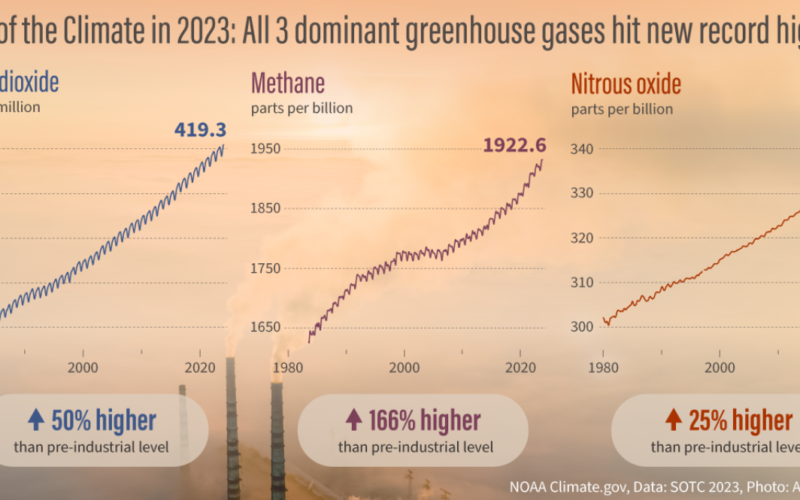In 2023, greenhouse gas concentrations, global temperatures over land and ocean, sea levels, and ocean heat content all reached unprecedented levels, as revealed in the 34th annual State of the Climate report.
This report, published by the Bulletin of the American Meteorological Society (BAMS) and spearheaded by scientists from the National Oceanic and Atmospheric Administration’s (NOAA) National Centers for Environmental Information (NCEI), is a comprehensive assessment drawing on the expertise of nearly 600 scientists from 60 countries. It provides an extensive update on Earth’s climate indicators, significant weather events, and data from monitoring stations on land, water, ice, and space.
“The BAMS State of the Climate report is the product of an international effort to more fully understand global climate conditions in 2023. This report documents and shares a startling, but well-established picture. We are experiencing a warming world as I speak, and the indicators and impacts are seen throughout the planet. The report is another signpost to current and future generations,” said NCEI Director Derek Arndt.
Notably, global temperatures soared to record highs, with analyses indicating that the annual global surface temperature was between 0.99 and 1.08 degrees Fahrenheit (0.55 to 0.60 degrees Celsius) above the 1991–2020 average, making 2023 the warmest year since records began in the mid-to-late 1800s, surpassing the previous record set in 2016. The shift from La Niña to a strong El Niño in the Pacific Ocean during the year contributed significantly to this record-breaking warmth. All seven major global temperature datasets used in the report concur that the past nine years (2015–2023) have been the warmest on record.
In 2023, Earth’s greenhouse gas concentrations reached their highest levels ever recorded. The primary atmospheric greenhouse gases — carbon dioxide, methane, and nitrous oxide — once again saw record-high concentrations. The average annual increase in global CO2 levels has risen from 0.6 parts per million (ppm) per year in the early 1960s to an average of 2.5 ppm per year over the past decade (2014–2023).
El Niño conditions also contributed to record-high sea surface temperatures. Emerging in the equatorial Pacific Ocean during the spring of 2023, El Niño intensified throughout the year, leading to a mean annual global sea-surface temperature in 2023 that surpassed the previous 2016 record by 0.23 degrees Fahrenheit (0.13 degrees Celsius). Each month from June to December was the warmest on record, with an all-time high daily sea-surface temperature of 66.18 degrees Fahrenheit (18.99 degrees Celsius) recorded on August 22, 2023. Approximately 94% of the ocean surface experienced at least one marine heatwave in 2023, defined as sea-surface temperatures in the warmest 10% of all recorded data at a specific location for at least five days.
The ocean’s heat content and global sea levels also reached record highs. Over the past 50 years, the ocean has absorbed over 90% of the excess energy trapped in Earth’s system due to greenhouse gases and other factors. The global ocean heat content, measured from the surface to a depth of 2000 meters (over 6,500 feet), continued to rise and reached new record highs in 2023. Global mean sea level was at a record high for the 12th consecutive year, standing about 4.0 inches (101.4 millimeters) above the 1993 average (the start of satellite altimetry measurements).
Heatwaves and droughts fueled massive wildfires around the world. In late spring and a record-hot summer, approximately 37 million acres burned across Canada, more than double the previous record from 1989 and an area more than twice the size of Ireland. Nearly 232,000 people were evacuated due to wildfire threats, and
smoke from these fires affected regions across Canada, heavily populated U.S. cities like New York City and Chicago, and even parts of western Europe.
In Australia, millions of acres of bushfires raged for weeks in the Northern Territory during September and October. In mid-August to early September, the European Union’s largest wildfire since records began in 2000 burned hundreds of thousands of acres in Greece.
The Arctic saw its fourth-warmest year on record, with summer (July to September) being the warmest ever. The seasonal Arctic minimum sea-ice extent, typically reached in September, was the fifth-smallest in the 45-year record. The amount of multiyear ice — ice that survives at least one summer melt season — continued to decline, with the Arctic nearly devoid of ice older than four years since 2012.
Meanwhile, Antarctic sea ice set record lows throughout 2023, with eight months seeing new monthly mean record lows in sea ice extent and area. A total of 278 days in 2023 set new daily record-low sea ice extents, with both Antarctic sea ice extent and area reaching all-time record lows on February 21, 2023, surpassing the previous record lows set in February 2022.
Tropical cyclone activity was below average, with 82 named tropical storms, fewer than the 1991–2020 average of 87. However, seven tropical cyclones reached Category 5 intensity on the Saffir-Simpson Hurricane Wind Scale. Globally, accumulated cyclone energy — a combined measure of the strength, frequency, and duration of tropical storms and hurricanes — rebounded from the lowest level in the 43-year record in 2022 to above average in 2023.





















